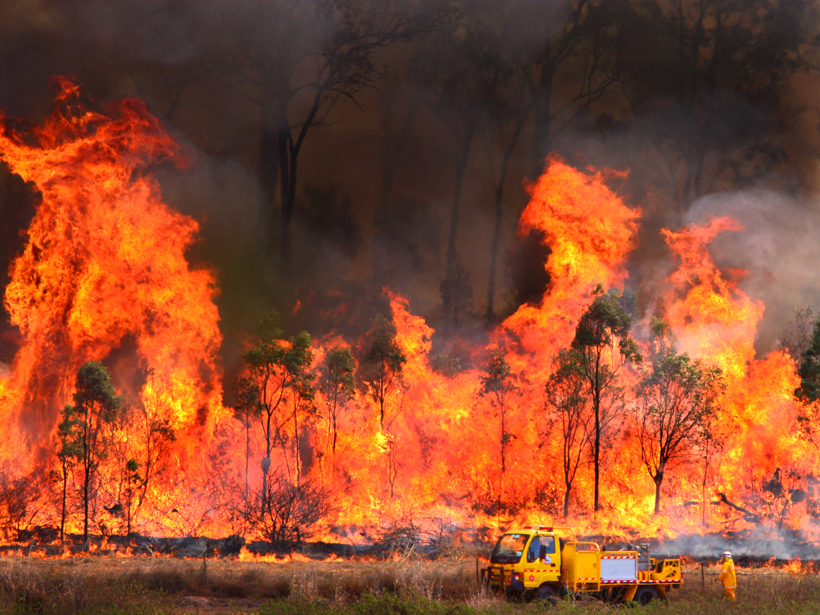Climate scientists and their backers across the globe are decrying plans by Australia’s national research institute to scale back its work on basic climate science in favor of research into coping with climate change.
Some 350 of roughly 5200 employees of the Commonwealth Scientific and Industrial Research Organisation (CSIRO) could lose their positions and be replaced with hires in other research areas over the next 2 years as part of the plan by agency chief executive Larry Marshall. “The overall number of people in CSIRO is projected to be unchanged at the end of a 2-year period,” Marshall said in a statement.
Details Scarce
Officials have confirmed that the agency could reduce climate measurement and modeling staff by roughly half.
Details remain scarce on which specific climate research topics will shoulder the burden. But CSIRO officials have confirmed that the agency could reduce climate measurement and modeling staff by roughly half, with some of them potentially moving to outside research institutions.
Opponents of the proposal, which started to attract media attention last week, have said it could severely curb the agency’s basic climate science capabilities and hurt, not help, Australia’s ability to respond to climate change. “It is a bad comment about Australia’s scientific reputation,” John Church, head of CSIRO’s sea level rise program, told Eos. He has been speaking out strongly against the agency’s proposed changes.
In an email to his staff, Sydney-based Marshall, an engineer and tech entrepreneur, said last week that the country was in need of science that could spur innovation in a changing global economy. He said the plans for CSIRO climate research reflected his assessment that researchers had already learned enough “to prove global climate change.”
“That question has been answered, and the new question is what do we do about it, and how can we find solutions for the climate we will be living with?” said the message, obtained by the Sydney Morning Herald.
Global Backlash
The proposal has since sparked a global backlash. The climate research wing of the World Meteorological Organization (WMO), a United Nations agency, condemned it.
“We read that these cuts occur in the name of innovation,” said the statement from WMO’s World Climate Research Programme (WCRP). “One can hardly imagine a worse and more backward step toward any of those laudable goals than ignoring climate and discarding climate research.”
The WCRP found “most worrisome” Marshall’s suggestion to shift toward climate impacts simply because researchers had resolved the issue of climate change’s existence. Researchers are still trying to understand climate change’s detailed workings and its effects, the statement said.
In another reaction to the pending changes, more than 2900 scientists signed a letter sent to CSIRO and Australian officials noting that the Paris climate agreement reached in December stressed the need to boost scientific knowledge on climate change. “CSIRO’s decision to slash climate research will severely curtail Australia’s capacity to deliver on these key promises,” said the letter, obtained by Eos.
Praising Realigned Priorities
Some others have defended CSIRO’s moves. Richard Colbeck, who is both an Australian senator with the ruling Liberal Party and a government minister involved with trade, investment, tourism, and international education, praised the “realigning of priorities.”
“It’s a really important thing that CSIRO [is] doing because it is researching actually how we manage the effects of climate change.”
“It’s a really important thing that CSIRO [is] doing because it is researching actually how we manage the effects of climate change,” such as more frequent and severe bushfires, he told the Australian Broadcasting Corporation.
Marshall also justified the change of focus, stressing the need for research that spurs innovation. Marshall told an Australian Senate panel, whose proceedings were webcast, that he was “very surprised” by all the criticism, but he requested patience as CSIRO officials continued consulting with staff on the changes.
No Net Loss
He denied that CSIRO would suffer a net loss of staff, telling senators that some staffers would be retrained or reassigned to other institutions and additional ones hired in other research areas. He also noted that CSIRO accounts for just 16% of Australia’s environmental research capacity.
He asserted that CSIRO would continue running its Cape Grim station for greenhouse gas monitoring and other programs for studying ocean conditions, as well as maintain its climate models. And he stressed that CSIRO would find ways to keep gathering data with fewer staff, such as by crowdsourcing refinements to its models and deploying autonomous underwater vehicles into the oceans.
Church, however, suggested that the quality of work might suffer with fewer scientists. “In that sense, his statement is misleading,” Church said.
Risky Maneuvers?
John Connor, CEO of the Climate Institute of Australia, a nonprofit advocacy group working against climate change, warned that shifting staff and projects to other research institutions could carry its own risks. Other institutions are continually competing for limited—and, more recently, declining—government funding, he said in an interview. “We would counsel against a quick fix which leaves those capabilities exposed to future sorts of financing challenges,” he said.
Senator Kim Carr of Australia’s Labor Party echoed these concerns at the Senate panel hearing. “Who has the capacity that matches anything like the CSIRO does in these areas and has the security of funding?” Carr asked.
CSIRO deputy chief Craig Roy, without offering specifics, responded that the agency has made a commitment “to maintain the facilities.”
—Puneet Kollipara, Freelance Writer; email: [email protected]
Editor’s Note: See the Editors’ Vox post by Susan Trumbore, editor in chief of Global Biogeochemical Cycles, for additional perspectives on this news.
Citation: Kollipara, P. (2016), Scientists denounce pending Australian climate science cuts, Eos, 97, doi:10.1029/2016EO046103. Published on 12 February 2016.
Text © 2016. The authors. CC BY-NC 3.0
Except where otherwise noted, images are subject to copyright. Any reuse without express permission from the copyright owner is prohibited.

